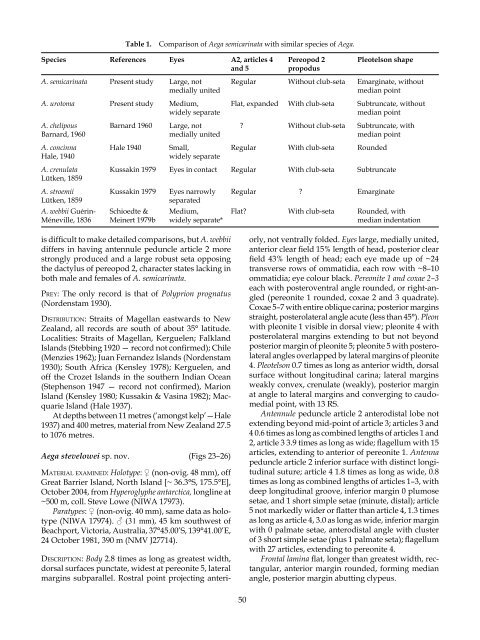The Marine Fauna of New Zealand: Isopoda, Aegidae (Crustacea)
The Marine Fauna of New Zealand: Isopoda, Aegidae (Crustacea)
The Marine Fauna of New Zealand: Isopoda, Aegidae (Crustacea)
Create successful ePaper yourself
Turn your PDF publications into a flip-book with our unique Google optimized e-Paper software.
table 1. Comparison <strong>of</strong> Aega semicarinata with similar species <strong>of</strong> Aega.<br />
species references Eyes A2, articles 4 pereopod 2 pleotelson shape<br />
and 5 propodus<br />
A. semicarinata Present study Large, not Regular Without club-seta Emarginate, without<br />
medially united median point<br />
A. urotoma Present study Medium, Flat, expanded With club-seta Subtruncate, without<br />
widely separate median point<br />
A. chelipous Barnard 960 Large, not ? Without club-seta Subtruncate, with<br />
Barnard, 960 medially united median point<br />
A. concinna Hale 940 Small, Regular With club-seta Rounded<br />
Hale, 940 widely separate<br />
A. crenulata Kussakin 979 Eyes in contact Regular With club-seta Subtruncate<br />
Lütken, 859<br />
A. stroemii Kussakin 979 Eyes narrowly Regular ? Emarginate<br />
Lütken, 859 separated<br />
A. webbii Guérin- Schioedte & Medium, Flat? With club-seta Rounded, with<br />
Méneville, 836 Meinert 979b widely separate* median indentation<br />
is difficult to make detailed comparisons, but A. webbii<br />
differs in having antennule peduncle article 2 more<br />
strongly produced and a large robust seta opposing<br />
the dactylus <strong>of</strong> pereopod 2, character states lacking in<br />
both male and females <strong>of</strong> A. semicarinata.<br />
prey: <strong>The</strong> only record is that <strong>of</strong> Polyprion prognatus<br />
(Nordenstam 930).<br />
distribution: Straits <strong>of</strong> Magellan eastwards to <strong>New</strong><br />
<strong>Zealand</strong>, all records are south <strong>of</strong> about 35° latitude.<br />
Localities: Straits <strong>of</strong> Magellan, Kerguelen; Falkland<br />
Islands (Stebbing 1920 — record not confirmed); Chile<br />
(Menzies 962); Juan Fernandez Islands (Nordenstam<br />
930); South Africa (Kensley 978); Kerguelen, and<br />
<strong>of</strong>f the Crozet Islands in the southern Indian Ocean<br />
(Stephenson 1947 — record not confirmed), Marion<br />
Island (Kensley 980; Kussakin & Vasina 982); Macquarie<br />
Island (Hale 937).<br />
At depths between metres (‘amongst kelp’—Hale<br />
937) and 400 metres, material from <strong>New</strong> <strong>Zealand</strong> 27.5<br />
to 076 metres.<br />
Aega stevelowei sp. nov. (Figs 23–26)<br />
materiaL examined: Holotype: ♀ (non-ovig. 48 mm), <strong>of</strong>f<br />
Great Barrier Island, North Island [~ 36.3°S, 75.5°E],<br />
October 2004, from Hyperoglyphe antarctica, longline at<br />
~500 m, coll. Steve Lowe (NIWA 7973).<br />
Paratypes: ♀ (non-ovig. 40 mm), same data as holotype<br />
(NIWA 7974). ♂ (31 mm), 45 km southwest <strong>of</strong><br />
Beachport, Victoria, Australia, 37°45.00’S, 39°4 .00’E,<br />
24 October 98 , 390 m (NMV J277 4).<br />
desCription: Body 2.8 times as long as greatest width,<br />
dorsal surfaces punctate, widest at pereonite 5, lateral<br />
margins subparallel. Rostral point projecting anteri-<br />
50<br />
orly, not ventrally folded. Eyes large, medially united,<br />
anterior clear field 15% length <strong>of</strong> head, posterior clear<br />
field 43% length <strong>of</strong> head; each eye made up <strong>of</strong> ~24<br />
transverse rows <strong>of</strong> ommatidia, each row with ~8– 0<br />
ommatidia; eye colour black. Pereonite 1 and coxae 2–3<br />
each with posteroventral angle rounded, or right-angled<br />
(pereonite rounded, coxae 2 and 3 quadrate).<br />
Coxae 5–7 with entire oblique carina; posterior margins<br />
straight, posterolateral angle acute (less than 45°). Pleon<br />
with pleonite visible in dorsal view; pleonite 4 with<br />
posterolateral margins extending to but not beyond<br />
posterior margin <strong>of</strong> pleonite 5; pleonite 5 with posterolateral<br />
angles overlapped by lateral margins <strong>of</strong> pleonite<br />
4. Pleotelson 0.7 times as long as anterior width, dorsal<br />
surface without longitudinal carina; lateral margins<br />
weakly convex, crenulate (weakly), posterior margin<br />
at angle to lateral margins and converging to caudomedial<br />
point, with 3 RS.<br />
Antennule peduncle article 2 anterodistal lobe not<br />
extending beyond mid-point <strong>of</strong> article 3; articles 3 and<br />
4 0.6 times as long as combined lengths <strong>of</strong> articles and<br />
2, article 3 3.9 times as long as wide; flagellum with 15<br />
articles, extending to anterior <strong>of</strong> pereonite . Antenna<br />
peduncle article 2 inferior surface with distinct longitudinal<br />
suture; article 4 .8 times as long as wide, 0.8<br />
times as long as combined lengths <strong>of</strong> articles –3, with<br />
deep longitudinal groove, inferior margin 0 plumose<br />
setae, and short simple setae (minute, distal); article<br />
5 not markedly wider or flatter than article 4, 1.3 times<br />
as long as article 4, 3.0 as long as wide, inferior margin<br />
with 0 palmate setae, anterodistal angle with cluster<br />
<strong>of</strong> 3 short simple setae (plus 1 palmate seta); flagellum<br />
with 27 articles, extending to pereonite 4.<br />
Frontal lamina flat, longer than greatest width, rectangular,<br />
anterior margin rounded, forming median<br />
angle, posterior margin abutting clypeus.

















